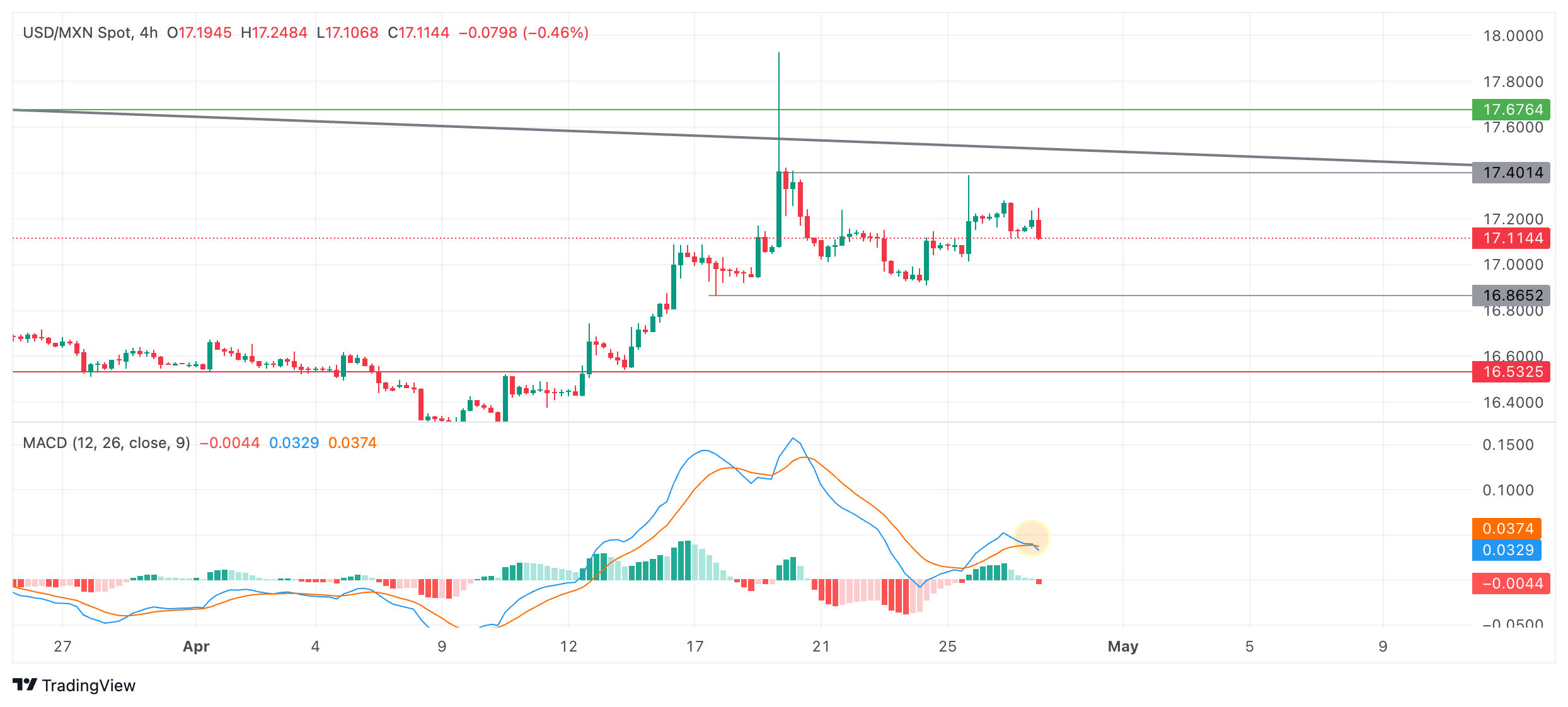- The Mexican Peso rises as sentiment improves due to gains for tech giants and the easing of real-estate regulations in China.
- Microsoft and Alphabet stock prices soared at the end of last week, lifting the whole market higher.
- Speculation of the Chinese authorities easing property market regulations helps soothe investor fears, further supporting sentiment.
The Mexican Peso (MXN) trades higher against its key counterparts on Monday morning on the back of a wave of positive market sentiment. Asian stock indices noted gains at the end of their session, with Hong Kong’s Hang Seng Index up 1.6% and China’s Shanghai Composite closing up 0.79%.
USD/MXN is trading down 0.45% at 17.08, EUR/MXN is down over 0.28% at 18.29 and GBP/MXN is down at 21.41, at the time of publication during the US session.
Mexican Peso rises on wave of positive risk sentiment
The Mexican Peso makes gains at the start of the week as risk sentiment turns positive on speculation the Chinese Communist Party Central Committee's Political Bureau will meet in late April to discuss loosening property policies, according to Reuters.
Market sentiment is being further buoyed by the strong gains seen in US stocks on Friday as a result of expectation-beating first quarter results from Alphabet (GOOG) and Microsoft (MSFT).
On the data front, the Mexican labor market showed resilience after the release of the Unemployment Rate, which came in lower-than-expected at 2.3% in March from 2.5% previously, according to figures from INEGI. Analysts had been expecting a lesser decline to 2.4%.
Balance of Trade data, released at the same time, showed a higher-than-expected surplus of $2.098 billion in March from $1.195B in the same month of the previous year, and February’s 0.585B deficit, according to data from INEGI. The result was above expectations of a 0.700B surplus.
The data is more likely than not to lead the Banxico to delay further interest-rate cuts. The central bank reduced interest rates from 11.25% to 11.00% at its March meeting, however, it said future cuts would be data dependent. Maintaining higher interest rates for longer is likely to support the Mexican Peso going forward as higher interest rates attract more capital inflows.
Technical Analysis: USD/MXN extends sideways trend
USD/MXN extends its sideways trend over the short-term horizon as it continues to seesaw between tepid gains and losses between range lows in the 16.80s and highs in the 17.40s.
USD/MXN 4-hour Chart
The Moving Average Convergence/ Divergence (MACD) momentum indicator has just crossed below its signal line, giving a sell signal and indicating the likelihood that USD/MXN will continue falling to the range floor. The signal is enhanced by the fact that MACD is more reliable in sideways market conditions.
A decisive breakout of the range, either below the range floor at 16.86 or range ceiling at 17.40, would change the directional bias of the pair.
A break below the floor could see further downside to a target at 16.50, followed by the April 9 low at 16.26.
On the other side, a breakout higher would activate an upside target first at 17.67, piercing a long-term trendline and then possibly reaching a further target at around 18.15.
A decisive break would be one characterized by a longer-than-average green or red daily candlestick that pierces above or below the range high or low, and that closes near its high or low for the period; or three green/red candlesticks in a row that pierce above/below the respective levels.
Banxico FAQs
The Bank of Mexico, also known as Banxico, is the country’s central bank. Its mission is to preserve the value of Mexico’s currency, the Mexican Peso (MXN), and to set the monetary policy. To this end, its main objective is to maintain low and stable inflation within target levels – at or close to its target of 3%, the midpoint in a tolerance band of between 2% and 4%.
The main tool of the Banxico to guide monetary policy is by setting interest rates. When inflation is above target, the bank will attempt to tame it by raising rates, making it more expensive for households and businesses to borrow money and thus cooling the economy. Higher interest rates are generally positive for the Mexican Peso (MXN) as they lead to higher yields, making the country a more attractive place for investors. On the contrary, lower interest rates tend to weaken MXN. The rate differential with the USD, or how the Banxico is expected to set interest rates compared with the US Federal Reserve (Fed), is a key factor.
Banxico meets eight times a year, and its monetary policy is greatly influenced by decisions of the US Federal Reserve (Fed). Therefore, the central bank’s decision-making committee usually gathers a week after the Fed. In doing so, Banxico reacts and sometimes anticipates monetary policy measures set by the Federal Reserve. For example, after the Covid-19 pandemic, before the Fed raised rates, Banxico did it first in an attempt to diminish the chances of a substantial depreciation of the Mexican Peso (MXN) and to prevent capital outflows that could destabilize the country.
Information on these pages contains forward-looking statements that involve risks and uncertainties. Markets and instruments profiled on this page are for informational purposes only and should not in any way come across as a recommendation to buy or sell in these assets. You should do your own thorough research before making any investment decisions. FXStreet does not in any way guarantee that this information is free from mistakes, errors, or material misstatements. It also does not guarantee that this information is of a timely nature. Investing in Open Markets involves a great deal of risk, including the loss of all or a portion of your investment, as well as emotional distress. All risks, losses and costs associated with investing, including total loss of principal, are your responsibility. The views and opinions expressed in this article are those of the authors and do not necessarily reflect the official policy or position of FXStreet nor its advertisers. The author will not be held responsible for information that is found at the end of links posted on this page.
If not otherwise explicitly mentioned in the body of the article, at the time of writing, the author has no position in any stock mentioned in this article and no business relationship with any company mentioned. The author has not received compensation for writing this article, other than from FXStreet.
FXStreet and the author do not provide personalized recommendations. The author makes no representations as to the accuracy, completeness, or suitability of this information. FXStreet and the author will not be liable for any errors, omissions or any losses, injuries or damages arising from this information and its display or use. Errors and omissions excepted.
The author and FXStreet are not registered investment advisors and nothing in this article is intended to be investment advice.
Recommended content
Editors’ Picks

Gold surges to fresh record high above $3,400 Premium
Gold extends its uptrend and trades at a new all-time high above $3,400 on Monday. Concerns over a further escalation in the US-China trade war and the Fed’s independence smash the US Dollar to three-year troughs, fuelling XAU/USD's rally.

EUR/USD clings to strong gains near 1.1500 on persistent USD weakness
EUR/USD gains more than 1% on the day and trades at its highest level since November 2021 near 1.1500. The relentless US Dollar selling helps the pair push higher as fears over a US economic recession and the Federal Reserve’s autonomy grow.

GBP/USD tests 1.3400 as USD selloff continues
GBP/USD continues its winning streak, testing 1.3400 on Monday. The extended US Dollar weakness, amid US-Sino trade war-led recession fears and heightened threat to the Fed's independence, underpin the pair following the long weekend.

An ambush for the ages
The dollar continued to get sold going into last weekend, but not as badly as one would think given the bad economic reports on Thursday... The BBDXY ended the week at 1,224

Five fundamentals for the week: Traders confront the trade war, important surveys, key Fed speech Premium
Will the US strike a trade deal with Japan? That would be positive progress. However, recent developments are not that positive, and there's only one certainty: headlines will dominate markets. Fresh US economic data is also of interest.

The Best brokers to trade EUR/USD
SPONSORED Discover the top brokers for trading EUR/USD in 2025. Our list features brokers with competitive spreads, fast execution, and powerful platforms. Whether you're a beginner or an expert, find the right partner to navigate the dynamic Forex market.




